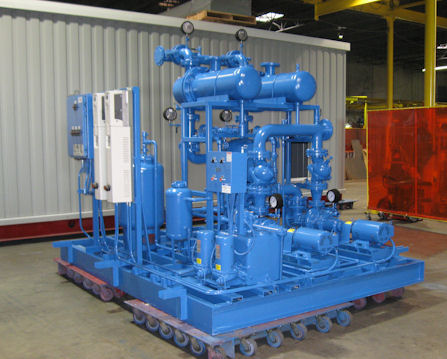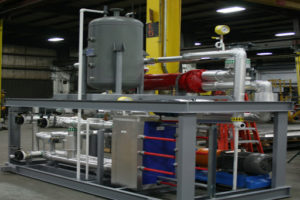How To Optimize Thermal Conductivity with DVS Heat Transfer Systems in Extreme Environments
Wiki Article
A Comprehensive Overview to Picking the Right Heat Transfer Systems for Your Needs
Choosing the suitable Heat transfer system is necessary for functional effectiveness. Different systems cater to various requirements, influenced by elements such as temperature range and liquid kind. Understanding the principles behind Heat transfer, such as convection, radiation, and conduction, is crucial. Additionally, reviewing power sources and maintenance methods can impact long-lasting efficiency. A closer evaluation of these factors to consider exposes how to tailor a system to certain requirements. What should one prioritize in this complex decision-making procedure?Comprehending Heat Transfer: Trick Ideas and Principles
Although Heat transfer may look like a simple idea, it incorporates a variety of principles that are essential for effective system design. Recognizing these principles is necessary for designers and designers who intend to optimize thermal performance in various applications. Conduction, for example, includes the transfer of Heat through solid products, while convection refers to the activity of Heat within liquids. Radiation, another essential principle, explains exactly how Heat can be moved through electro-magnetic waves. Each of these devices plays an important duty in identifying exactly how energy moves within a system. By thoroughly understanding these ideas, specialists can make informed choices, ensuring that Heat transfer systems operate efficiently and meet the particular needs of their applications
Sorts Of Heat Transfer Equipments: An Introduction
Comprehending the principles of Heat transfer lays the groundwork for discovering the numerous kinds of Heat transfer systems readily available. Heat transfer systems can be categorized primarily into 3 kinds: convection, radiation, and transmission. Conduction involves Heat transfer through strong materials, relying upon direct get in touch with in between bits. Convection, on the other hand, takes place in fluids (gases and fluids) where the movement of the fluid itself promotes Heat transfer. Radiation involves the transfer of Heat through electro-magnetic waves and does not need a tool, enabling it to take place in a vacuum. Each sort of system has distinctive characteristics and applications, making it essential for individuals and companies to very carefully analyze their certain requirements when selecting the most suitable Heat transfer option.Applications of Heat Transfer Solutions in Numerous Industries
Heat transfer systems play a crucial role across numerous markets, affecting effectiveness and item quality. In industrial production processes, they help with specific temperature control, while in food and beverage processing, they ensure safety and security and conservation. Additionally, cooling and heating and climate control systems count heavily on reliable Heat transfer to keep comfortable environments.Industrial Production Processes

Various commercial production processes rely heavily on effective Heat transfer systems to maximize productivity and improve product top quality. In industries such as metalworking, Heat exchangers play a crucial duty in maintaining perfect temperatures during welding, casting, and forging. These systems guarantee uniform Heat distribution, which is vital for achieving desired material residential properties. In the chemical manufacturing sector, Heat transfer systems promote specific temperature control throughout reactions, impacting yield and safety and security. In fabric manufacturing, reliable Heat management is important for coloring and completing processes, influencing color consistency and material quality. By picking appropriate Heat transfer technologies, suppliers can boost energy efficiency and reduce functional expenses, inevitably causing a much more sustainable and affordable production atmosphere.
Food and Drink Processing
Reliable Heat transfer systems are just as essential in the food and drink processing industry, where keeping optimal temperatures is important for food security and top quality. These systems play a necessary function in processes such as sanitation, cooking, and pasteurization, making sure that items are secure for usage and maintain their dietary value. Heat exchangers, as an example, effectively move Heat between liquids, enhancing energy usage while lessening temperature variations. In addition, refrigeration systems are basic for extending and preserving disposable products life span. The choice of Heat transfer technology directly influences functional performance and product stability, making it necessary for food and beverage suppliers to select the ideal systems customized to their certain processing demands. This careful option ultimately adds to consumer contentment and food safety.
Heating And Cooling and Environment Control
While numerous sectors depend on Heat transfer systems for performance, HVAC (Home Heating, Ventilation, and Cooling) plays a necessary duty in preserving indoor climate control throughout different settings. These systems use Heat transfer principles to control temperature, humidity, and air high quality, making sure comfort and safety and security in property, business, and commercial environments. Effectively developed a/c systems boost energy efficiency, decrease operational expenses, and minimize environmental effect. In industrial buildings, for instance, efficient environment control contributes to worker efficiency and customer satisfaction. In industrial applications, a/c systems help preserve suitable conditions for tools procedure and product conservation. Choosing the ideal Heat transfer system is vital for meeting details climate control requirements and achieving overall system efficiency.Assessing Energy Resources for Heat Transfer Equipments
In evaluating energy sources for Heat transfer systems, a comparison of eco-friendly energy options and nonrenewable fuel source considerations is important. Sustainable resources, such as solar and wind, offer sustainable alternatives that can decrease ecological impact. On the other hand, fossil fuels remain prevalent due to their well established framework and power density, prompting a mindful assessment of both choices.Renewable Resource Options

Fossil Gas Factors To Consider
Assessing fossil fuel factors to consider is necessary for the efficiency and sustainability of Heat transfer systems. Fossil gas, such as gas, oil, and coal, are conventional power resources that offer significant Heat output, making them preferred options for industrial and household applications. Their environmental impact, consisting of greenhouse gas emissions and source depletion, increases concerns. When picking a heat transfer system, it is crucial to evaluate the schedule, cost, and regulatory variables related to these gas. Additionally, the performance of nonrenewable fuel source systems have to be taken into consideration, as higher performance can mitigate some ecological drawbacks. Inevitably, a balanced technique weighing performance and sustainability can assist decision-makers toward the most proper Heat transfer service for their certain demands.Elements to Take Into Consideration When Picking a Heat Transfer System
Choosing an ideal Heat transfer system requires careful factor to consider of various aspects that can considerably influence effectiveness and performance. One important variable is the operating temperature level range, which dictates the materials and style ideal for the application. Additionally, the kind of fluid utilized in the system-- whether gas or fluid-- influences Heat transfer effectiveness and compatibility. The system's size and capacity must line up with the details needs of the procedure to avoid inefficiencies. Energy source accessibility is likewise crucial, affecting operating costs and sustainability. Furthermore, the setup environment, including space restrictions and accessibility for maintenance, plays a considerable function in system selection. Regulatory conformity and safety and security requirements should be considered to assure the system fulfills all legal requirements.Upkeep and Performance Optimization for Heat Transfer Systems
Keeping Heat transfer systems is vital for guaranteeing optimal effectiveness and longevity. Regular upkeep activities, such as cleansing Heat exchangers and examining insulation, aid stop effectiveness losses due to fouling and thermal linking. Furthermore, keeping track of system parameters, consisting of pressure and temperature level, enables very early detection of abnormalities, lessening downtime and costly repair services. Executing a preventative maintenance timetable can enhance efficiency and extend the life-span of components. Upgrading to sophisticated control systems can boost functional performance by changing to varying tons and problems. By focusing on upkeep and performance optimization, operators can accomplish minimized power intake, reduced operational expenses, and improved general system integrity, eventually bring about better source application and an extra sustainable procedure.Future Patterns in Heat Transfer Technologies
As markets progressively prioritize sustainability and power effectiveness, future trends in Heat transfer modern technologies are established to undertake considerable changes. Innovations such as innovative products, consisting of carbon nanotubes and nanofluids, assure enhanced thermal conductivity and efficiency. Furthermore, the integration of eco-friendly energy resources into Heat transfer systems is acquiring momentum, promoting environmentally friendly remedies. Smart technologies, consisting of IoT sensing units, are expected to transform tracking and control, making it possible for real-time data evaluation for enhanced efficiency. Additionally, the growth of small and modular systems will certainly help with less complicated installment and maintenance, catering to diverse applications. These improvements indicate a change towards more sustainable, effective, and adaptable Heat transfer services, straightening with worldwide power objectives and ecological standards.
Frequently Asked Questions
What Are the Ecological Influences of Heat Transfer Solutions?
The environmental influences of Heat transfer systems can include greenhouse gas emissions, energy usage, and potential thermal air pollution. In addition, incorrect disposal of ineffectiveness and materials can add to source depletion and community disruption.How Do I Calculate the Cost-Effectiveness of a Warm Transfer System?
To determine the cost-effectiveness of a warm transfer system, one have to examine first expenses, functional expenditures, upkeep requirements, and power effectiveness, comparing these aspects versus the expected life-span and performance of the system.Can Heat Transfer Solution Be Made Use Of in Residential Settings?
Heat transfer systems can undoubtedly be made use of in domestic setups. They supply effective home heating and cooling down solutions, making homes extra comfy while potentially reducing energy costs. Their flexibility enables various applications in residential environments.What Safety Laws Put On Heat Transfer Systems?
Safety and security laws for Heat DVS Heat Transfer Systems transfer systems typically include guidelines on installment, operation, and maintenance. Compliance with neighborhood structure codes, supplier specifications, and market standards is important to assure reliable and safe system performance in different applications.How Do Different Materials Affect Heat Transfer Effectiveness?

Conduction, for instance, involves the transfer of Heat with strong products, while convection refers to the movement of Heat within liquids. Recognizing the principles of Heat transfer lays the groundwork for checking out the different kinds of Heat transfer systems readily available. Heat exchangers, for instance, effectively transfer Heat between fluids, optimizing power usage while minimizing temperature level fluctuations. In assessing power resources for Heat transfer systems, a contrast of sustainable energy choices and fossil gas considerations is essential. Metals, such as copper and aluminum, conduct Heat properly, whereas insulators like rubber and glass reduce down Heat circulation.
Report this wiki page